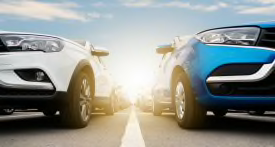The Vietnamese automaker rushed to the U.S. market with a luxury-inspired EV crossover—and it shows
VinFast is the latest automaker to enter the U.S. market with ambitious plans on electric vehicles. Started in 2017, this young Vietnamese company has been selling models overseas for a few short years. Now, it has introduced its stateside products: the VF8 two-row midsized SUV, followed by the VF9 three-row midsized SUV.
Initially, these models will be imported and sold while the company constructs a factory in North Carolina. The stated intent is to produce U.S.-market vehicles there starting in about 2028. This would enable the company to benefit from federal incentives and potentially avoid any import tariffs. Beyond the midsized SUVs, Vinfast says that smaller VF6 and VF7 crossover EVs are in the works.
CR recently rented a VinFast VF8 for our first drive, so we could report to readers what they might expect as quickly as possible. We’ve heard that assembly of the 2025 model year starts this winter with a facelift and software update, so given these rapid changes, Consumer Reports will wait to buy one to formally test, possibly until they are built in the U.S.
The VF8 is offered initially in two configurations: Eco ($46,000) and Plus ($51,800). The Eco has 348 hp and a 264-mile EPA-certified electric range, whereas the Plus has 402 hp and a 243-mile range. The company claims the VF8 can be charged from 10 to 70 percent in 31 minutes on a DC fast charger.
The company prides itself on rapid vehicle development, aiming to outpace legacy automakers with just two- to three-year timelines from design to production. That is quite ambitious, when established corporations take about twice that time. Legacy automakers also benefit from deep knowledge bases for all manner of benchmarks, from vehicle dynamics and safety equipment to small things like appropriate door weight, steering resistance, and feel for controls.
Ultimately, this is a key part of the story: It is clear from the 2024 VF8 Plus AWD that we rented from the automaker that a slower pace might have allowed more refinement.
The electric SUV will compete with the Ford Mustang Mach-E, Hyundai Ioniq 5, Kia EV6, Subaru Solterra, Tesla Model Y, Toyota bZ4X, and Volkswagen ID.4.























